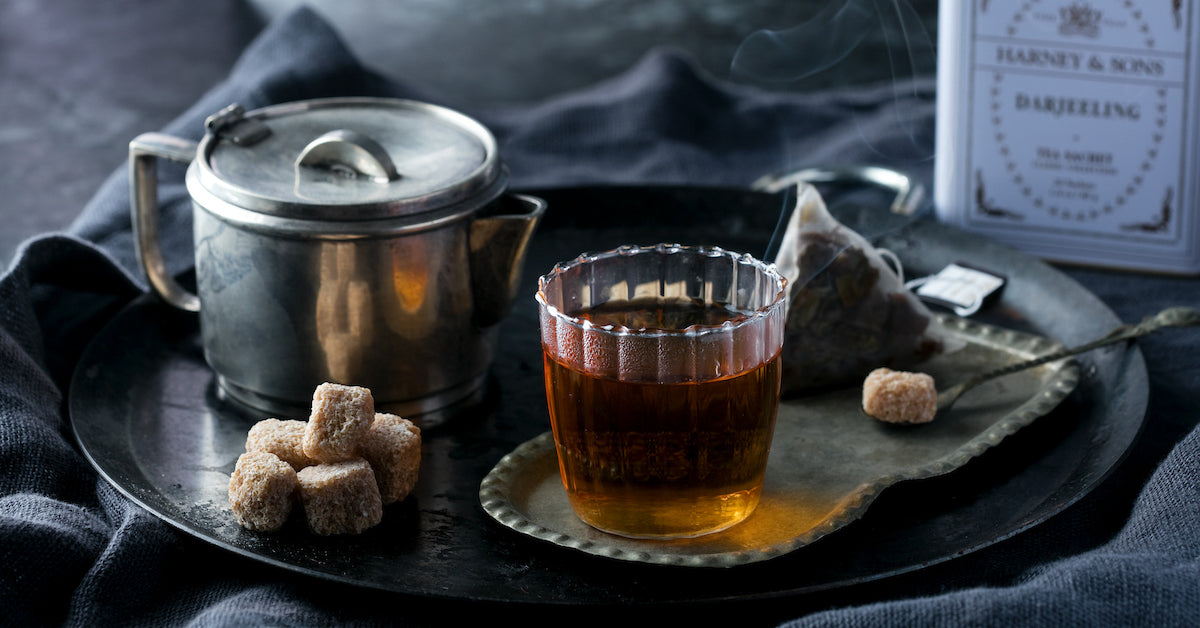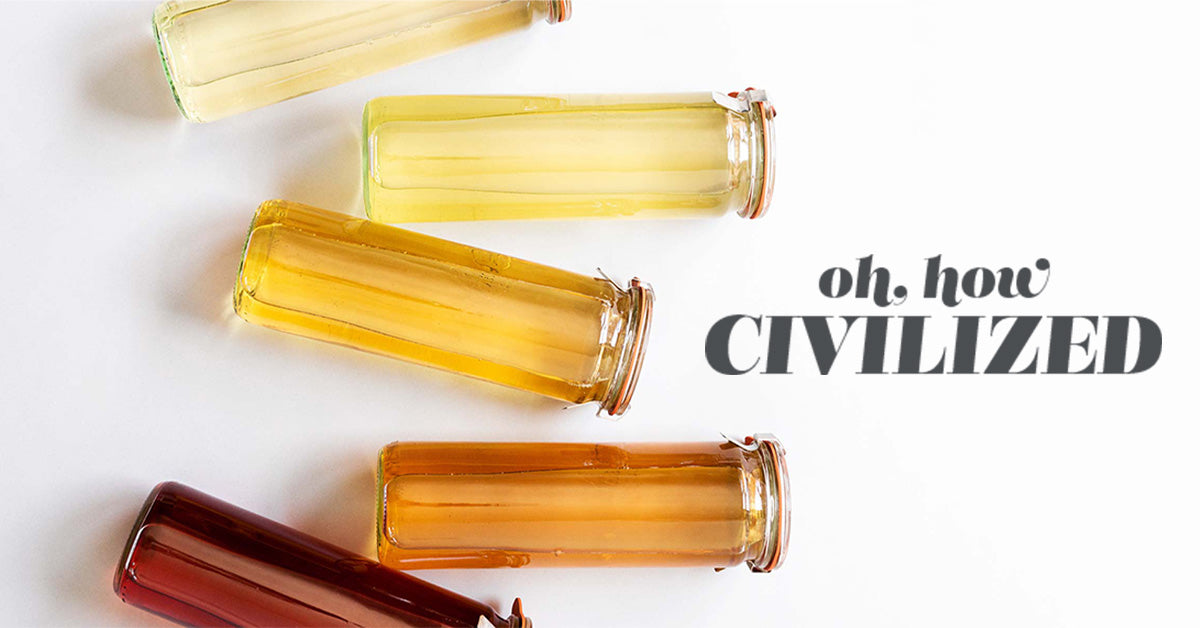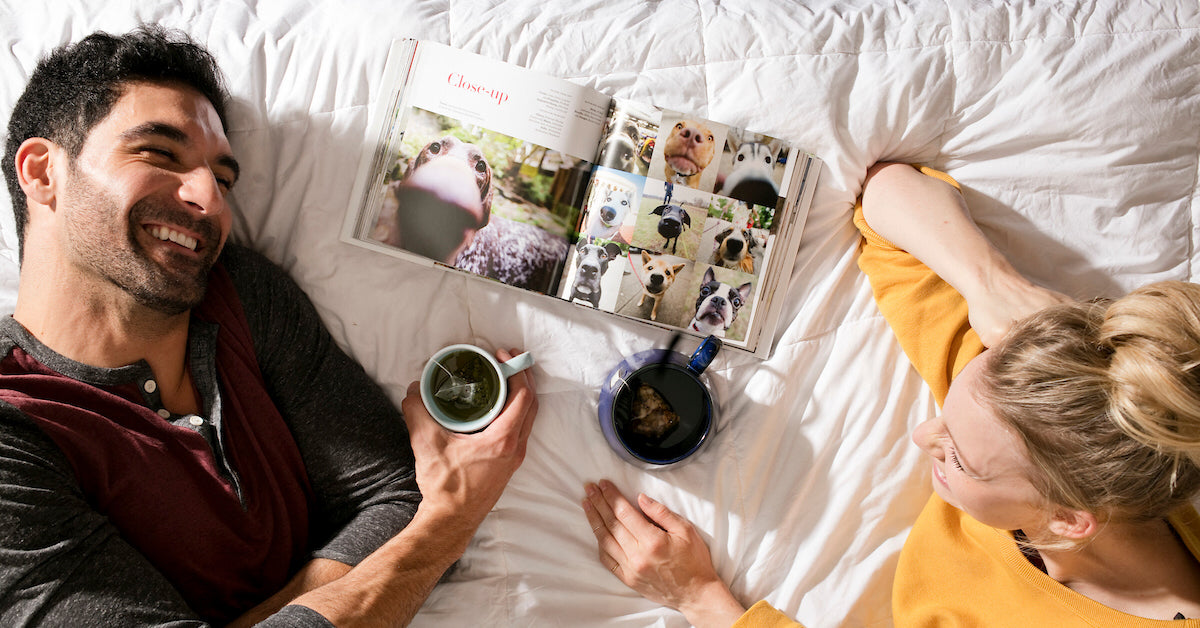This month, I’m spilling the Darjeeling tea! Darjeeling is a special black tea. It is only from the northern part of India that is close to Nepal and Sikkim. Darjeeling is a protected geographical area to ensure that tea sold as Darjeeling is from Darjeeling. The Darjeeling we carry here at Harney & Sons, of course, follows these requirements.
I have often used the term “champagne of teas” when referring to Darjeeling, but have not been able to find a convincing origin story as to this nomenclature. Another reason, I believe, is the pale green tea of Darjeeling reminds some of champagne wine. Also, champagne is the best quality sparkling wine, and Darjeeling is one of the best black teas.
Another phrase I use when referring to Darjeeling is British Legacy Tea. What do I mean by that? Well, British Legacy teas refer to teas that the British developed when they controlled India and Sri Lanka (Ceylon). After the British left, the local tea growers followed what the British did and implemented many tweaks to improve the teas. Darjeeling became a tea-growing area in the 1850s and a powerhouse a few decades later.

If you’re wondering how tea got to India in the first place since there were no tea plants in Darjeeling originally, here’s how: it hitched a ride with the British! When the first tea plants came with Robert Fortune (taken from China without permission), they were grown in the hills on the other side of India. Later, some were taken up to Darjeeling, which had a nicer climate in comparison to the heat and humidity of Calcutta (Kolkata).
There are still plants called “Chinese” found all through Darjeeling, and they produce some of the best tea. Also, tea bushes were found in the nearby Assam area. So later, these hardy plants were grown in the mountains of Darjeeling. These plants, called Assamica, make a coarser tea, but they produce large volumes.
So, let’s talk about Darjeeling’s growing season. It starts late in the winter in Darjeeling, around January, when the plant responds to the increasing length of the day and starts to send stored liquid energy up from the roots. This is similar to what maple trees do when they send sap up (and how we love that sap when it is boiled down to maple syrup!). The plant uses that new liquid energy to start growing new leaves. When those leaves are the correct size (late March and early April), they are hand plucked and made into First Flush Darjeeling.
But it’s not done yet. The plant keeps using the stored energy, and then one day the energy is tapped out, which means no more new leaves are made. This is called the In-Between tea - this is not a good tea and little is made. In a few weeks, the energy levels have been refilled by the abundant sun of April and May, and the leaves start growing again. When plucked in a few weeks, it is the start of the Second Flush.
This continues for about a month, and then the rains from the monsoons come in late May to mid-June. Besides the excess moisture, the rain clouds block the energy from the sun; thus there is little tea made for several months, and it is generally not very good. Late September or so, the monsoons ebb and the tea plant starts to make reasonable tea. However, the season is very short because of the shorter days and chilly fall weather. This is the elusive Autumnal Flush. We try to get it each year and seem to be stymied. Soon the plant shuts down and awaits the next spring.

These seasonal differences in the Darjeeling tea-growing region isn’t just about how the tea grows – it’s also about how it tastes. Originally developed by the British for the British, there was a certain uniformity in the tea’s characteristics. It was a dark tea that worked well with milk and sugar, and that was good for many decades. After the British left India in 1947, the tea style remained the same. However, there was ferment in the air, and change was coming.
Young Indian producers looked to get more money, and young German tea buyers felt that there was a market for different styles of tea. Ranabir Sen was a young Indian tea maker, and Bernd Wulf was a German striving to make his mark in the tea world. Bernd was the father of our main tea supplier, Marcus Wulf. Those two experimented with lightening the teas to let the leaves' flavorful qualities come through. They made a tea that was lighter and greener. There is an old black and white picture of those two with some tea in front of a British (BOAC) plane. That was another innovation, putting tea on a plane. Get that fresh tea to the market while people could enjoy that freshness.
Later, the Japanese grew to like these teas and asked the Indians to make them even greener - the way they like their Senchas. Thus, a First Flush is a light tea with an almost green color. This makes for a very brisk tea with tropical fruit aromas. My wife, Brigitte, likes to drink these during the heat of the summer (so I follow her lead).
The Second Flush has a style of its own. The leaves are different – tougher and bigger – so the tea is handled differently. The leaves are rolled harder and oxidized longer to make a darkish tea. There are many more insects during the heat of May and June; one of those sometimes found are green leafhoppers called Jacobiasca formosana. The tea leaves are eaten by these leafhoppers and in reaction produce a chemical to repel these invaders. It turns out that we love the dark fruity flavor of that reaction. It makes a tea called Muscatel (after the wonderful muscat grapes). Hard to find but worth the effort.
As mentioned previously, we source our Darjeeling from Marcus Wolf’s tea exporting company. The British loved a uniform tea that worked well with milk and sugar. When Marcus’ father, Bernd Wulf, made teas according to the seasons, it became clear that certain tea estates were better than others. Some of that was the location and terroir, and some of that was the estate’s management. Of course, one encourages the other. Since each year reshuffles the cards, we depend upon Marcus to find the best Darjeelings.

My personal Darjeeling favorite seems to be the Risheehat First Flush, and the teas from Namring often please me. An old friend used to own Okayti, and Marcus’ father is buried there, so that is a nostalgic fave. I remember being at Selimbong (often a great producer) and watching my son Emeric do some handstand yogaish pose at sunrise, so that also is one I look to. Side note on Okayti: Situated on a lovely corner of a road through the Mirik Valley in the Darjeeling district, it is a stunningly beautiful garden. When Bernd Wolf died, his ashes were scattered there. Whenever we are in the area, a visit is mandatory. Also, Queen Victoria found teas from this garden enjoyable. Legend credits her for the name: after trying it, she pronounced that it was indeed “okay tea.”
On the business side of Darjeeling, one of the other legacies the British left besides this wonderful tea is the practice of having a workforce living on or near the tea estate where they work. There is a trade of essential services and supplies by the owners for discounted labor rates; nowadays, it favors neither and needs to be unwound. However, like a car stuck in mud, little happens, but hope springs. The best us outsiders can do is to buy Darjeeling from the tea producers that are changing slowly. We need Darjeeling not to collapse but rather figure out how to endure and keep making great teas and treating its employees better.
Meanwhile, brew up a cuppa Darjeeling and enjoy an especially fine black tea. Here’s to the champagne of teas – cheers!





12 comments
Joe
You mention using airplanes to get fresh tea to consumers. Many years ago (20+ ?) my partner went on a trip with her father that passed through Darjeeling. I told her she had better get at least 4 ounces of Darjeeling tea, or don’t bother coming back ;)
Well, the guide took her into the market and helped her choose some tea. It was very fresh, not completely dried out, and had some flowers in it. I can’t describe its taste, but it was ambrosial. We nursed that 4 ounces over several months.
You mention using airplanes to get fresh tea to consumers. Many years ago (20+ ?) my partner went on a trip with her father that passed through Darjeeling. I told her she had better get at least 4 ounces of Darjeeling tea, or don’t bother coming back ;)
Well, the guide took her into the market and helped her choose some tea. It was very fresh, not completely dried out, and had some flowers in it. I can’t describe its taste, but it was ambrosial. We nursed that 4 ounces over several months.
Andrea Daniels
Thank you for this information about Darjeeling tea. I have yet to try it, but this article has moved me forward to just that! I am unable to attend the Tea Expo in Seattle this year, but feel that I have had some tea education when I read your articles. You are my very favorite tea supplier and I appreciate your connection to your customers with your writings. Happy Fall!
Thank you for this information about Darjeeling tea. I have yet to try it, but this article has moved me forward to just that! I am unable to attend the Tea Expo in Seattle this year, but feel that I have had some tea education when I read your articles. You are my very favorite tea supplier and I appreciate your connection to your customers with your writings. Happy Fall!
Kathy
Thank you for the article. Darjeeling is one of my favorite teas!
Thank you for the article. Darjeeling is one of my favorite teas!
Joe Pendergrass
I very much enjoyed the article getting a little more insight to the world (and nuances) of Darjeeling. I learned a lot from a short read. I started out dedicated to Formosa Oolong, then switched over time to Darjeeling. Now, after a conversation with Mike (and associated tasting), I now alternate between Darjeeling and Oolong. But Darjeeling remains my personal favourite.
I very much enjoyed the article getting a little more insight to the world (and nuances) of Darjeeling. I learned a lot from a short read. I started out dedicated to Formosa Oolong, then switched over time to Darjeeling. Now, after a conversation with Mike (and associated tasting), I now alternate between Darjeeling and Oolong. But Darjeeling remains my personal favourite.
Steven
What happened to Margaret’s Hope? That was my favorite modestly priced tea. I have missed it every since it was dropped from your line of teas.
What happened to Margaret’s Hope? That was my favorite modestly priced tea. I have missed it every since it was dropped from your line of teas.
Sandra M.
I’m a Southerner & avid tea drinker. Grew up drinking Southern sweet iced tea, but these days one of my favorite teas is Earl Grey. Like it hot with half & half. Really enjoy reading your informative articles about different teas, how & where each is grown, & background history. Thanks for sharing.
I’m a Southerner & avid tea drinker. Grew up drinking Southern sweet iced tea, but these days one of my favorite teas is Earl Grey. Like it hot with half & half. Really enjoy reading your informative articles about different teas, how & where each is grown, & background history. Thanks for sharing.
Natalie K
Nice information, Hope is there to save Darjeelings . My fav from Harney is the Indian Nimbu enjoy both hot and iced. Mke a picture of iced every week. The aroma is superb. Enjoy the educational journey.
Nice information, Hope is there to save Darjeelings . My fav from Harney is the Indian Nimbu enjoy both hot and iced. Mke a picture of iced every week. The aroma is superb. Enjoy the educational journey.
Karen van der Veer
What a treasure trove of information and enlightenment. Thank you for the teas you source, your commitment to them (in every aspect, from start to finish), and for sharing your knowledge and passion. What a gift! I’m envious of the beautiful work you do and wish I, too, could make a career of it.
Gratitude and love to you and your family.
What a treasure trove of information and enlightenment. Thank you for the teas you source, your commitment to them (in every aspect, from start to finish), and for sharing your knowledge and passion. What a gift! I’m envious of the beautiful work you do and wish I, too, could make a career of it.
Gratitude and love to you and your family.
Valerie Johnston
“The British are coming; The British are coming! There is always something to learn about tea, good or bad. This phrase was attributed to Paul Revere. Unlike America, the British made its way to Darjeeling and remained. That tea has grown stronger and better with time. If we become even more fortunate with this legacy how much more fortunate can we become? We must be patient and see. While waiting, we can enjoy how fortunate we are now.
“The British are coming; The British are coming! There is always something to learn about tea, good or bad. This phrase was attributed to Paul Revere. Unlike America, the British made its way to Darjeeling and remained. That tea has grown stronger and better with time. If we become even more fortunate with this legacy how much more fortunate can we become? We must be patient and see. While waiting, we can enjoy how fortunate we are now.
Carol Guilfoyle
Thank you so much for this article on Darjeeling! It is one of my very favorite teas for the afternoon; very relaxing, and I believe it truly is the “champagne” of teas. I buy it from you in the 50 sachet bags, as I drink it every afternoon. Keep up the good work, and thanks again for your informative articles.
Thank you so much for this article on Darjeeling! It is one of my very favorite teas for the afternoon; very relaxing, and I believe it truly is the “champagne” of teas. I buy it from you in the 50 sachet bags, as I drink it every afternoon. Keep up the good work, and thanks again for your informative articles.
Eve Hill
Thanks, Mike, for the Darjeeliing piece. They’ve always been my favorite teas, along with a good Ching Wo. I do remember meeting Marcus Wulf at a Harney Tea event once when your father introduced us.
This week I have my Wedgwood Royal Blue Coronation teapot out in honor of her late Majesty. I’m considering which Harney tea to make in it Monday morning, for it has never been used, so far as I know. Remembering Father John’s recounting of his invitation and trip to England for dinner with Queen Elizabeth is giving me a smile and needs to be celebrated to honor both of them.
Thanks, Mike, for the Darjeeliing piece. They’ve always been my favorite teas, along with a good Ching Wo. I do remember meeting Marcus Wulf at a Harney Tea event once when your father introduced us.
This week I have my Wedgwood Royal Blue Coronation teapot out in honor of her late Majesty. I’m considering which Harney tea to make in it Monday morning, for it has never been used, so far as I know. Remembering Father John’s recounting of his invitation and trip to England for dinner with Queen Elizabeth is giving me a smile and needs to be celebrated to honor both of them.
Cindy
Thanks. That was really interesting.
Thanks. That was really interesting.